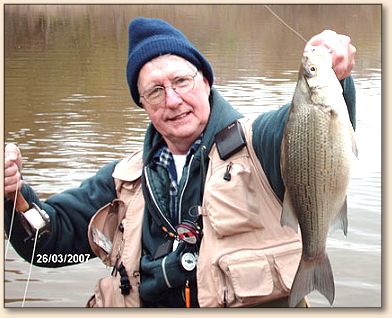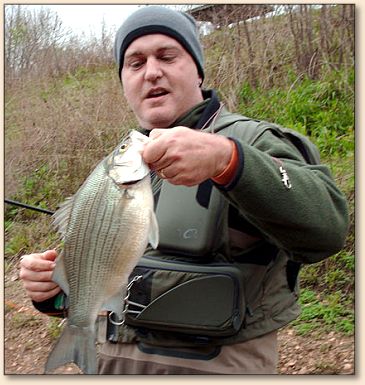 Another White Bass season in the Ozarks seems to have drawn
to a close. Every spring, these hearty bass – the "ugly stepsister"
of the freshwater bass family – go into a spawning frenzy in
many Ozarks streams, rivers, and lakes. Generally speaking,
the combination of spring rains and water temperatures climbing
into the sixties triggers their procreative instinct and the
spawning runs begin. White Bass spawning runs on Ozark streams
vary based on the weather and from fishery to fishery over a
couple of months, but generally occur in March and April. And
they rarely happen in more than one or two of our rivers at the
exact same time. They do tend to overlap, but each fishery peaks
independently. Ozarks White Bass are caught mostly in the one to
three pound range, but four pound Whites are not unexpected, and
I got a very credible report of a six pound White being caught
this spring. But that would be a huge White Bass!
Another White Bass season in the Ozarks seems to have drawn
to a close. Every spring, these hearty bass – the "ugly stepsister"
of the freshwater bass family – go into a spawning frenzy in
many Ozarks streams, rivers, and lakes. Generally speaking,
the combination of spring rains and water temperatures climbing
into the sixties triggers their procreative instinct and the
spawning runs begin. White Bass spawning runs on Ozark streams
vary based on the weather and from fishery to fishery over a
couple of months, but generally occur in March and April. And
they rarely happen in more than one or two of our rivers at the
exact same time. They do tend to overlap, but each fishery peaks
independently. Ozarks White Bass are caught mostly in the one to
three pound range, but four pound Whites are not unexpected, and
I got a very credible report of a six pound White being caught
this spring. But that would be a huge White Bass!
Pound for pound, White Bass fight harder than most other bass species.
They also become incredibly aggressive feeders and are heavy schoolers
during the spawn. This makes White Bass fishing pretty exciting stuff.
When you factor in the sporadic and unpredictable nature of the White
Bass runs in the Ozarks, spring becomes an intoxicating time of year
for serious Ozarks fly anglers who know that you can catch other fish
than trout on a fly rod. All of our devoted trout fishing buddies wonder
where we disappear to. When the runs end and we return to the trout
streams, they always ask us why we haven't been fishing. If they only knew!
During the runs, it is not uncommon to land twenty to fifty White
Bass in a day of fishing in the right place at the right time...
sometimes even in half a day of fishing. If you find them on one
of the waters known to hold bigger fish, 20 or more bass in excess
of three pounds each is a spectacular day of fishing! A fellow fly
angler I introduced to the White Bass world this spring caught ten
such fish in three hours and was worn out. He quit fishing – completely
sated. His big fish was over four pounds.
Fly anglers have to think a bit differently when fishing for White
Bass than they do for trout. Muddy water is not a bad thing with
White Bass during the spawn. Tie on a Clouser Minnow or big, heavy
chartreuse, blue, or white Woolly Bugger and have fun! The best
Clouser colors are gray/white, chartreuse/white, and blue/white.
Size 8 or 10 streamers are best. And you can catch them with a 3X
leader and a floating line in most streams. In lakes, you need an
intermediate line or about a 300 grain sink tip. You will catch most
of these fish at less than three feet deep in water up to ten feet
deep. But during spawning runs in shallow streams, most strikes
occur in less than three feet of water on a suspended streamer.
Jerk-stripping the fly works best. You can also catch White Bass
on 1/100th ounce micro-jigs in white, gray, olive, blue, and
sometimes pink. These can be thread jigs, but Marabou works best.
Dead drift these under an indicator in swift water. On slower water
and lakes, you can also catch them on mostly white pencil poppers
and other similar popper flies. And if you find them feeding on
the surface like that, Katy bar the door!
Don't chase White Bass in the Ozarks on anything smaller than a
five weight fly rod. I prefer rods in the six to eight weight
category. These are spawning fish. They are very, very hearty
fish and their spawning activity really isn't damaged by being
caught during a spawning run. Nonetheless, they need their energy.
So unless you are keeping them for the fryer, you don't want to play
them out to exhaustion. And the heavier rod helps with windy spring
days following rains and the heavier flies, but it also helps you
land these bass more quickly. The Ozarks sees a very heavy harvest
of White Bass every year from bait and spin fishermen. And this
doesn't seem to harm the fisheries at all. White Bass are extremely
plentiful where they occur. Personally, I release all of mine.
I'm not fond of eating bass.
Historically, some of the best White Bass fisheries in the Ozarks
are the Little Sac River North of Springfield, Missouri, the lower
James River upstream of the James River arm of Table Rock Lake, the
Kings River branch of the same lake, the White River below Beaver
Dam in Arkansas, and the far upper end of Bull Shoals Lake just
below Powersite Dam. Feeder creeks and their associated coves
in these areas are important not to overlook. Fishing behind
rains that swell the creeks is the best bet, but ideally you
want to catch the water as it begins to clear and slow down
again. Fish the fast water just upstream of where it slows
at the confluence. But this is by no means the only place
you will find spawning run Whites!
We had a weird spring this year, and this disrupted the
spawning pattern. We had a very warm March followed by a
very cold April. We actually had hard freezes in mid-April.
So the runs began early in some places, but then shut down
as water temperatures dropped back into the fifties and even
forties in most streams and lakes. Toward the end of April,
the weather abruptly warmed back up and the White Bass went
berserk! But they were very bipolar. They were either going
crazy or completely dormant. So timing became as much a
function of luck as it ever has been for experienced White
Bass fishermen. We heard a lot of "you should have been
here yesterday!"

So, in early spring, when your options are to stay indoors a
bit longer or try to fish to lethargic northern trout in
ice-cold waters to our north, don't forget the White Bass
runs in the Ozarks. The weather can be very balmy and it
can be rainy and windy with highs in the forties. But our
waters never freeze and the Whites always spawn in March
and April. It is always over by mid-May. Tie up some
Clouser Minnows and micro-jigs and pack your bass rods.
Come prepared for cold, wet weather and for dry warm weather.
Bring a few dollars to spend in our local fly shops and at
Bass Pro Shop in Springfield or Branson. Eat a few meals
in local mom-and-pop cafes. Rent a cabin, cheap motel room,
or a spot in an RV park for your motor home. They're
everywhere down here. And try your hand at one of the
less known high quality early spring fly fishing
experiences in the country. ~ Ken
About Ken:
Ken graduated from Southern Methodist University
in 1988, and spent the next several years serving
in the United States Navy as an intelligence analyst
and Russian Language translator. He is a veteran
of Desert Shield and Desert Storm. Leaving the
nation's service in 1993.
Ken is also a published outdoor writer and historian,
having penned articles and stories that have appeared
in several national hunting publications like North
American Hunter magazine, on GunMuse.com, in regional
and local newspapers, and historical and literary
journals. He has also provided hunting and dog
training seminars for Bass Pro Shops and other
sporting goods retailers nationwide. He volunteers
his time to Ducks Unlimited and Trout Unlimited,
as well as several local charitable organizations.
He is also a REALTOR with Coldwell Banker in
Springfield, Missouri; where he lives with his wife,
Wilma, and their Weimaraner, Smoky Joe.
|

 Another White Bass season in the Ozarks seems to have drawn
to a close. Every spring, these hearty bass – the "ugly stepsister"
of the freshwater bass family – go into a spawning frenzy in
many Ozarks streams, rivers, and lakes. Generally speaking,
the combination of spring rains and water temperatures climbing
into the sixties triggers their procreative instinct and the
spawning runs begin. White Bass spawning runs on Ozark streams
vary based on the weather and from fishery to fishery over a
couple of months, but generally occur in March and April. And
they rarely happen in more than one or two of our rivers at the
exact same time. They do tend to overlap, but each fishery peaks
independently. Ozarks White Bass are caught mostly in the one to
three pound range, but four pound Whites are not unexpected, and
I got a very credible report of a six pound White being caught
this spring. But that would be a huge White Bass!
Another White Bass season in the Ozarks seems to have drawn
to a close. Every spring, these hearty bass – the "ugly stepsister"
of the freshwater bass family – go into a spawning frenzy in
many Ozarks streams, rivers, and lakes. Generally speaking,
the combination of spring rains and water temperatures climbing
into the sixties triggers their procreative instinct and the
spawning runs begin. White Bass spawning runs on Ozark streams
vary based on the weather and from fishery to fishery over a
couple of months, but generally occur in March and April. And
they rarely happen in more than one or two of our rivers at the
exact same time. They do tend to overlap, but each fishery peaks
independently. Ozarks White Bass are caught mostly in the one to
three pound range, but four pound Whites are not unexpected, and
I got a very credible report of a six pound White being caught
this spring. But that would be a huge White Bass!
